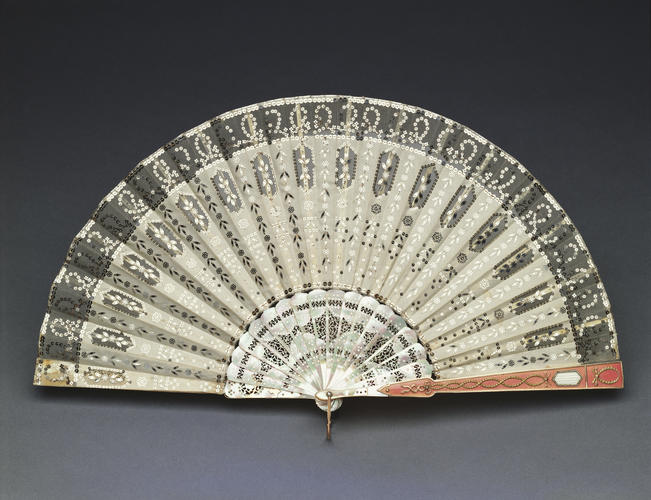-
1 of 253523 objects
Queen Elizabeth's Fabergé fan c. 1900
Cream silk and silk gauze leaf; front guard mother-of-pearl and two-colour gold enamelled in pink and white over a guilloché ground decorated with diamonds; sticks and back guard of pierced mother-of-pearl with silver piqué decoration (2 + 16); silver pin with diamond heads and gold loop | 24.2 cm (guardstick) | RCIN 25298

Mikhail Perkhin (1860-1903)
Master: Queen Elizabeth's Fabergé fan c. 1900

Mikhail Perkhin (1860-1903)
Master: Queen Elizabeth's Fabergé fan c. 1900

Mikhail Perkhin (1860-1903)
Master: Queen Elizabeth's Fabergé fan c. 1900



-
The firm of Fabergé was first established in St Petersburg in the 1840s, but its serious evolution dates from 1872, when Peter Carl Fabergé (1846-1920) took over the family business. From 1885 the firm was an official supplier to the Imperial Court and by 1910 Fabergé was the leading provider of jewellery, objects and silver to the Tsar and his family. To match the huge demand for his products, Fabergé introduced a highly organised system of workshops, each under its own workmaster, the most skilled of whom were elevated to the position of head workmaster.
The Royal Collection contains the largest group of works by Fabergé in existence, including three fans. The different marks applied by Fabergé’s head workmasters enable them to be quite precisely dated and attributed to a particular workmaster. In this case, we can be sure that the fan was made between 1896 and 1903 by Michael Perchin (1860-1903), Fabergé’s head workmaster from 1886 until his death in 1903. Unfortunately, it has not yet proved possible to discover the original purchaser of the fan, which is first recorded in the possession of Queen Elizabeth The Queen Mother.
The period when Perchin was in charge of Fabergé’s works is acknowledged as being particularly innovative, with the firm’s output covering a great range of different object types and styles. In this case the silk leaf, decorated with sequins and spangles, imitates early nineteenth-century fans. The intricately decorated sticks - here combining two-coloured gold over pink and white guilloché enamel - are a particular feature of Fabergé’s fans. A number of other fans produced by Perchin are known, several of which also have pink enamelled guards. A Perchin fan with lilac enamelled guards and sequinned silk gauze leaf was made for Queen Alexandra’s second daughter, Princess Victoria, at around the same date as the present fan (see lot 607, Harewood, Collecting in the Royal Tradition, Christie's London, 5 & 9 December 2012). However, fans were never more than a small proportion of Fabergé’s output. By the late nineteenth century fans were supplied by other firms, in both Moscow and St Petersburg; as in England, high-quality fans available in Russia were often made in Paris.
Mark of Michael Perchin; gold mark of 56 zolotniks (1896-1908)
Text adapted from Unfolding Pictures: Fans in the Royal Collection 2005Provenance
Belonged to Queen Elizabeth The Queen Mother
-
Creator(s)
(workmaster)(jeweller) -
Medium and techniques
Cream silk and silk gauze leaf; front guard mother-of-pearl and two-colour gold enamelled in pink and white over a guilloché ground decorated with diamonds; sticks and back guard of pierced mother-of-pearl with silver piqué decoration (2 + 16); silver pin with diamond heads and gold loop
Measurements
24.2 cm (guardstick)
Category
Object type(s)